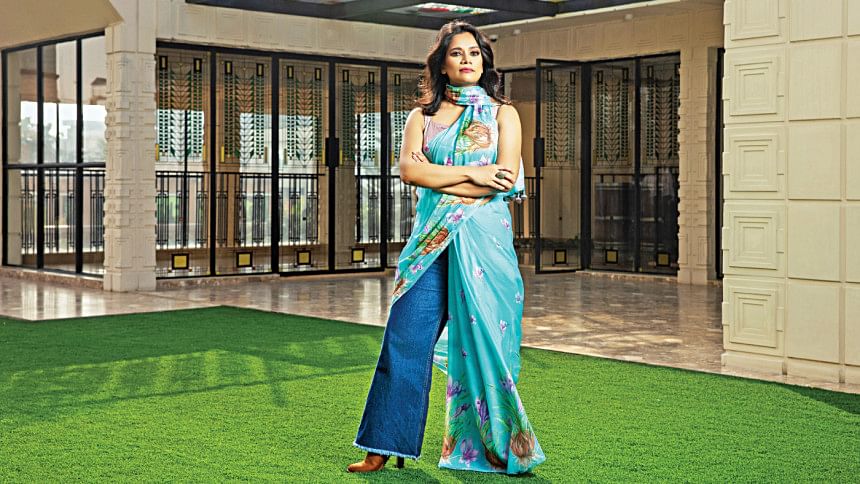Sari - The changing tale of draping

In the current fashion world, the sari, a traditional female garment of Bangladesh, India, Nepal, and Sri Lanka is all the rage. One of the most versatile garments in the world, the sari can be worn in more than a hundred ways. The rectangular piece of unstitched cloth, usually six yards in length, is commonly wrapped around the waist, pleated, and tucked over a petticoat with the other loose end of the fabric called 'anchal' drawn across the torso and draped over the left shoulder. A fitted blouse is also an essential part of this ensemble.
Considered quintessentially Indian, the sari has been influenced and inspired by many cultures and traditions. The first sari-like garment can be traced back to the Indus Valley Civilisation, which flourished in the northern parts of India around 2800-1800 BCE. Apparently, the first saris were made of cotton and soon, weavers learned to use natural dyes like indigo, turmeric, red madder, and flowers to bring variety.
Silk came into play around 2400 BCE. At that time, the sari was called 'sati,' meaning 'strip of cloth.' According to some costume historians, sati turned into 'dhoti,' which until the 14th century, was worn by both men and women. The idea is based on ancient sculptures that show women covering only the nether regions of their bodies. Both men and women were equally comfortable in leaving the upper half bare.
In some places, women would just wrap the fabric around their bodies like a sheath, the main purpose being to cover up. The length of the sari varied at different times as did the style of draping the cloth. Many of the Buddhist scriptures recorded that women wore breast bands and lengths of a third piece of cloth covering the head and shoulders like the modern-day 'orna.' They called the ensemble 'posak' or the attire. There was, however, no blouse or petticoat to accompany the sari.
Even in late 19th century Bengal, the sari was worn without a blouse or petticoat by the rich and the poor alike. Women draped the sari, which was shorter than today's standard six yards, in large box pleats to cover their lower limbs and wrapped the rest around their upper bodies leaving only the arms and hands visible.
The person who brought about a revolutionary change to this style was Jnanadanandini Devi, wife of Satyendranath Tagore, the elder brother of Rabindranath Tagore. As the wife of India's first Indian Civil Service officer, she had to travel widely to accompany her husband to various parts of home and abroad. She also had to adapt and invent styles to accommodate herself in the drawing rooms with European ladies. Sari without any kind of undergarment would have been considered scandalous in that community.
So, Jnanadanandini took inspiration from the fashionable Parsi ladies who had introduced the "Bombay dastur." The style shows draping their "Chinese embroidered crepe Gara saris in a quasi-Gujarati style," with the anchal coming in front over the right shoulder, held in place on their long-sleeved blouses with a brooch.
The Tagore family had already devised a tunic-like chemise in the style of Victorian ladies of England. Soon however, the cumbersome chemise was divided into a blouse and a petticoat; the blouse got a lot of attention, being decorated with lace, patchwork, and applique. Jnanadanandini reversed the Parsi straight style and drew the anchal across the bosom, to loop over the left shoulder and then bring it back under the right.
The front pleats of the modern-day sari were introduced by the Maharani Suniti Devi of Cooch Behar, who was quite a fashion icon in her time. According to some historians, the idea came from Ancient Greek sculptures, where goddesses are shown in flowing and pleated skirts. This addition allowed women to stride more freely than before. In the 1920s, chiffon and silk sari with gold jewellery became popular. Indira Devi, another Maharani of Cooch Behar, set quite a trend with white chiffon.

Saris became fashionable and more adaptable for middle-class women of Bengal when Suchitra-Uttam movies became popular. Suchitra Sen was undoubtedly the most glamorous actress of her time. Women copied not only her high-neck blouse and the Nivi style of draping sari, but also the way she spoke and carried herself. Apart from Suchitra, Supriya Choudhury also drew attention with her chiffon sari and sleeveless blouse with dramatic kohl eyes. She became the iconic fashionable Bengali woman.
There is much to say about the sari and its accompanying accessories, but if we talk only about the different draping styles, and the people who invented and adapted the styles, the story would remain incomplete.
Along with the fantastic progression of the sari, there is also the sad tale of the weavers of Bengal. During the Sultanate and Mughal periods, Bengal was renowned for its textile, the most famous being the 'muslin' and 'jamdani.' But that rich culture was destroyed when the British took over. The industrial revolution of Europe introduced mass factory production and the hand-operated looms in the Indian sub-continent failed to compete. Even after its independence, Bangladesh continued to face a crisis in the textile industry.
Sometime in the late 1980s and early 90s, a renewed interest from various quarters started to revive the weaving industry. Even though the attention was sporadic, there have been a few dedicated fashion designers and houses that have been able to take Bangladeshi handloom and materials to international platforms.
One such name is Bibi Russel, the 'Dream Weaver.' Under the label of "Bibi Productions," she brought out her line of clothing. The rural 'gamcha' gained international fame when she organised her first international fashion show in 1996. Since then, the gamcha sari has been quite trendy.
Rina Latif is another acclaimed fashion designer who has taken Bangladesh to new heights. A conceiver of high-end clotheslines, she has made a name for herself through the khadi, muslin, and jamdani. Her work has been displayed in prestigious shows in Europe, India, and Pakistan and her brand is an internationally coveted one to have emerged out of Bangladesh.
Among the fashion houses, Aarong has saris of all ranges and types. A visit to Aarong is essential for sari lovers. Only last year, Azmeri Haque Badhon, "one of the most coveted actresses of Bangladesh," dazzled the audience at the Cannes Film Festival when she arrived in a beige jamdani sari with silver-toned intricate motifs. She carried herself with utmost grace, and she also gave due credit to the Aarong team for her sari and other accessories.
In recent years, the sari has garnered much attention in the western world as well. Many fashion shows have introduced sari-gowns, sari-pants, T-shirt saris, and other funky styles. Blouses have evolved as well with daring cuts, with various kinds of sleeves, fronts, and backs. The oldest garment in the world, the sari seems far from being called outdated. On the contrary, it is gaining new looks, audience, and popularity, while also being able to find more people interested in donning it.
Photo: Shahrear Kabir Heemel
Model: Shanila Mehjabin
Wardrobe: NOBO Dhaka
Collection: Bangladeshi Heshel, both hand-painted and digitally printed 100 count Egyptian cotton kota
Makeup: Shababa Rashid
Hair: Mia Bella Salon
Styling: Saki Kazi and Shezami Khalil
The author is a writer, academic, and translator. Currently, she teaches English at the University of Liberal Arts Bangladesh.

 For all latest news, follow The Daily Star's Google News channel.
For all latest news, follow The Daily Star's Google News channel. 



Comments